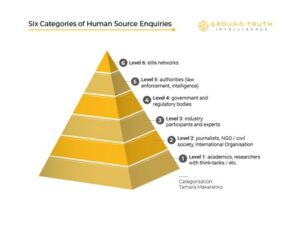 By Sylwia Wolos, Chief Strategy Officer, Ground Truth Intelligence
By Sylwia Wolos, Chief Strategy Officer, Ground Truth Intelligence
Innovation is transforming how businesses approach and conduct investigations. In the era of digitised data and AI-enabled technology, are human source enquiries still needed? Can “speaking to people” ever be innovative?
This article examines what human source enquiries are and how they add value as well as how they can be used successfully in particular as part of third party risk management programs.
What are human source enquiries?
Human source enquiries (HSE) are conversations conducted discreetly with very specific sources. There are three key reasons to engage HSE in the context of an investigation:
- To enhance results by finding what is otherwise hidden and unobtainable through open source research and publicly available data.
- To corroborate information collected via desktop research, including through internal and external datasets – both open and private – as well as in the surface, deep and dark web.
- To contextualise information previously collected by using local and expert knowledge.
Categorising human source enquiries
There are six main categories of sources grouped by their sensitivity and openness to engage:
All human source enquiries – even those conducted with ‘level 1’ sources – must be discreet. The aim of all source enquiries is to minimise any potential footprint and limit feedback to the target of enquiry.
When to use human source enquiries in third party risk management programs
Knowing when to use human source enquiries is a key instrument in an investigator’s toolkit, especially in relation to ESG issues that drive many of today’s high-risk due diligence investigations. And when it comes to third party risk management, conversations with the right sources can save an enormous amount of time, and money, by pointing you in the right direction early on, rather than leaving compliance teams to follow loose threads that don’t lead anywhere productive.
Here are three circumstances when HSE are essential and will justify the investment:
Public records constraints
There are many instances when the information availability trail ends for a researcher and human source enquiries offer a rich alternative. For example, when legislative frameworks do not require disclosure of key information such as human rights track records and ownership, or when, despite existing frameworks, a jurisdiction does not enforce requirements to disclose information.
In a recent project we saw a multinational business was looking to conduct enhanced due diligence on a European-based manufacturer, and its owners, in line with their risk-based approach to third-party risk management. The company had 10 subsidiaries across sub-Saharan Africa that also needed to be assessed for anti-bribery and corruption risks. Each subsidiary was subject to a red flag report initially, escalating straight away to higher levels of due diligence when issues of concern were found.
In particular, one subsidiary based in the Democratic Republic of Congo was cause for concern with media sources questioning a number of human rights abuses. Corporate records were unavailable for the entity and instead the business used a number of well-placed human sources to provide more detailed information. Through a number of trusted and well-placed human sources, the business obtained a picture of questionable business practices that confirmed the allegations.
The lack of public records in this situation was circumnavigated by accessing trusted experts at the highest level of human source complexity. Without this, the investigation would have lacked the critical information needed to manage the risk.
Other types of information are often knowingly hidden or deleted from private and public records, including political and business associations. Seasoned investigators will be aware of the growing number of professional facilitators developing creative solutions for hiding information including concealing associations through a complex web of entities and trusts, and professionally ‘cleaning up’ an individual’s online footprint. While such practices remain, human source enquiries play a key role in augmenting public record research.
Media limitations
While media searches remain a critical part of third party risk management, there are limitations on what gets written and published that must be considered. The challenge of the unknown-unknowns looms large – what if the investigator is missing a key piece of information because it was simply never published?
Investigators must look beyond the local press in some jurisdictions to uncover the true story. In jurisdictions that do not afford journalists and media organisations with robust protections, they can face legal and security risks that may disincentivise them from pursuing sensitive stories. In other instances a story may not be of interest to a wider audience so may not be pursued by the media. Human source enquiries, when executed correctly, can provide the missing pieces in these circumstances, especially for high risk third parties.
Context and corroboration of information
Human source enquiries also have a vital role to play in understanding the context of information, as well as corroborating it. Experts and well informed sources can be the key to a successful outcome by providing the relevant context, whether that is political, cultural, historical, or commercial.
For example, a comprehensive open source investigation in Turkey revealed media references to litigation records involving the subject, in contrast with actual litigation checks, which were empty. The inconsistency was resolved when local human sources elaborated on the level of political influence over local media. They also explained the past support the subject had provided to the opposition which led to the damaging articles published in the pro-government news outlets in light of upcoming elections. The sources could also explain, and provide other examples of, how such smear campaigns had been run in the country. Given the government’s control over the media, obtaining this context via human source enquiries was critical to the investigation.
Innovation in human source enquiries
There are two significant new trends when using human source enquiries for corporate investigations.
The first is the slowly emerging trend for transparency. We are moving away from smoke and mirrors private investigations to an open narrative that discusses the analysts’ techniques and methodologies as well as the real costs of human source enquiries. A modern day investigator now deploys a specific methodology – usually the intelligence cycle – and will refer to sources in a structured way.
The second important trend in this space is increased collaboration and partnership driven by the need for process efficiencies and predictable budgets. Access to a well cultivated, truly international network of contacts requires a significant time investment if done in-house. For corporate investigative units operating on a global scale, collaborating and accessing wider communities is especially beneficial, reducing the cost and time investments.
As long as global information gaps remain, whatever the reason, human source enquiries will continue to add significant value to corporate investigations and third party risk management. By understanding when, where and how to utilise them, they are transformed from just another tool in the kit to the modern investigator’s ‘special power’ when all other information routes are seemingly closed.


